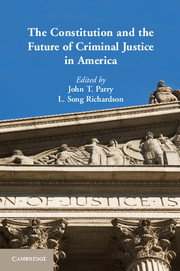Book contents
- Frontmatter
- Contents
- Contributors
- Acknowledgments
- Introduction
- Part I Foundations – The Scope of Criminal Law and Access to Counsel
- Part II Race and Criminal Procedure
- Part III Policing and Privacy
- 5 The Exclusionary Rule
- 6 Consent, Dignity, and the Failure of Scattershot Policing
- 7 Neurotechnologies at the Intersection of Criminal Procedure and Constitutional Law
- Part IV Technology and the Surveillance Society
- Part V Confessions and miranda
- Part VI Conviction, Sentencing, and Incarceration
- Part VII Emergencies and Borders – Immigration, Terrorism, National Security, and Transnational Crime
- Index
- References
5 - The Exclusionary Rule
Its Effect on Innocence and Guilt
Published online by Cambridge University Press: 05 June 2014
- Frontmatter
- Contents
- Contributors
- Acknowledgments
- Introduction
- Part I Foundations – The Scope of Criminal Law and Access to Counsel
- Part II Race and Criminal Procedure
- Part III Policing and Privacy
- 5 The Exclusionary Rule
- 6 Consent, Dignity, and the Failure of Scattershot Policing
- 7 Neurotechnologies at the Intersection of Criminal Procedure and Constitutional Law
- Part IV Technology and the Surveillance Society
- Part V Confessions and miranda
- Part VI Conviction, Sentencing, and Incarceration
- Part VII Emergencies and Borders – Immigration, Terrorism, National Security, and Transnational Crime
- Index
- References
Summary
The exclusionary rule is the principal constitutional remedy for police violations of Fourth Amendment rights. It prevents juries from considering relevant evidence, so as to deter future police misconduct. The Supreme Court acknowledges that preventing admission of potentially determinative evidence will allow some guilty defendants to go free, but it justifies the rule on the ground that no other remedy properly deters police abuse, harassment, or other misconduct. But this assumes two quite questionable facts. First, it assumes that the rule does actually effectively deter, despite the fact that there are still many incentives for police to engage in illegal evidence-gathering mechanisms: to get contraband off the street, to discourage crime by policing aggressively, to maintain arrest statistics, or to legally use illegally gained evidence in other ways, such as against coconspirators. Second, the Court’s analysis also assumes that the effect of the rule will only be to set some guilty people free, and not to convict some innocent people. Many scholars, judges, and lawyers have debated whether the exclusionary rule effectively deters police misconduct, but everyone has assumed that the second claim is obvious, since the exclusionary rule only excludes inculpatory evidence, not exculpatory evidence. This chapter outlines a different concern with the exclusionary rule: that it sets the guilty free at the expense of convicting innocent defendants.
- Type
- Chapter
- Information
- Publisher: Cambridge University PressPrint publication year: 2013



